 From the desk of Gus Mueller
From the desk of Gus Mueller
The 1960s were an exciting time for diagnostic audiology. We were moving beyond simple air and bone conduction threshold testing, and beginning to construct diagnostic tests that would allow us to identify pathologies of nerve VIII, the brainstem, and yes . . . even the brain.
In James Jerger's now classic 1963 book Modern Developments in Audiology, there was an intriguing review chapter on central auditory processing by Italians Bocca and Calearo. It was there that I first read about the "redundancy principle." Extrinsic, the linguistic redundancy of the test stimuli, versus intrinsic, the multiplicity of auditory processing pathways. Simply stated, when conducting clinical speech testing, the principle reminds us that the more subtle the auditory disorder, the more the redundancy of the test stimuli needs to be reduced for the speech test to be sensitive.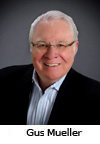 Certainly one way to reduce redundancy is to present different speech stimuli to the two ears simultaneously, which we refer to as dichotic testing. It was 50 years ago—in 1961—when Doreen Kimura published two articles describing how dichotic digit testing could be used to help describe central auditory processing. Her explanation of the crossed auditory pathways, ipsilateral suppression and the "right ear effect" has withstood the test of time, and laid the groundwork for the design and interpretation of many audiologic tests that followed.
Certainly one way to reduce redundancy is to present different speech stimuli to the two ears simultaneously, which we refer to as dichotic testing. It was 50 years ago—in 1961—when Doreen Kimura published two articles describing how dichotic digit testing could be used to help describe central auditory processing. Her explanation of the crossed auditory pathways, ipsilateral suppression and the "right ear effect" has withstood the test of time, and laid the groundwork for the design and interpretation of many audiologic tests that followed.
To celebrate the 50th anniversary of the publication of this germinal work, Dr. Kirmura has joined us this month at 20Q. She is Visiting Professor, Department of Psychology, Simon Fraser University, Burnaby, BC.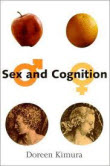 Doreen Kimura grew up in a small town near the Qu'Appelle Valley in southern Saskatchewan. By the age of 17, she was teaching in a one-room rural schoolhouse in northern Manitoba. She went on to attend McGill University in Montreal, where she eventually obtained her Ph.D., and studied with the noted neuropsychologists Donald Hebb and Brenda Milner. In her early career, she worked at the Montreal Neurological Institute, the University of California, Los Angeles Medical Center and the Zurich Kantonsspital in Switzerland. In 1967 she became professor in psychology at the University of Western Ontario, where she stayed until taking her current position at Simon Fraser in 1998.
Doreen Kimura grew up in a small town near the Qu'Appelle Valley in southern Saskatchewan. By the age of 17, she was teaching in a one-room rural schoolhouse in northern Manitoba. She went on to attend McGill University in Montreal, where she eventually obtained her Ph.D., and studied with the noted neuropsychologists Donald Hebb and Brenda Milner. In her early career, she worked at the Montreal Neurological Institute, the University of California, Los Angeles Medical Center and the Zurich Kantonsspital in Switzerland. In 1967 she became professor in psychology at the University of Western Ontario, where she stayed until taking her current position at Simon Fraser in 1998.
While the audiology world knows Dr. Kimura for her work relating to auditory processing, the rest of the world probably knows her best for her research regarding gender and cognition. Her book Sex and Cognition is widely acclaimed, and Dr. Kimura is one of the leading authorities in this sometimes controversial area of research.
On this 50th Anniversary, our 20Q article goes back to those early days of dichotic testing, but Dr. Kimura also reviews much of the research that has followed. I think you'll agree, it's been a pretty good 50 years. And to read a little more on the topic, check out what our special 20Q guests James Jerger, Jack Katz and Frank Musiek have to say.
Gus Mueller
Contributing Editor
August 2011
To browse the complete collection of 20Q with Gus Mueller articles, please visit www.audiologyonline.com/20Q
Editor's note: Excerpts of this 20Q were reprinted with permission from Elsevier from the article entitled "From ear to brain" by Doreen Kimura published in Brain & Cognition (In Press; doi:10.1016/j.bandc.2010.11.009). To access Brain and Cognition online, please visit: www.sciencedirect.com/science/journal/02782626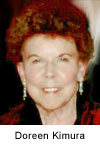 1. Fifty years? I sort of remember a "Kimura, 1961" reference when doing some reading on auditory processing. Are you that Kimura?
1. Fifty years? I sort of remember a "Kimura, 1961" reference when doing some reading on auditory processing. Are you that Kimura?
Yes that's me; a little worse for wear, but the right-ear effect is still going strong!
2. I'm impressed. Could you refresh my memory a little—exactly what is the "right-ear effect?"
The term "right-ear effect" or "right-ear advantage" can be used to describe different things, but in the field of audiology and auditory processing what we usually are referring to is an indirect effect of brain asymmetry for speech processing. That is, if we set up an auditory competition between the two ears (verbal stimuli reaching each ear simultaneously), the right ear usually wins because of the dominance of the left hemisphere for language processing. Recall that the auditory pathways from ear-to-brain are primarily crossed. The dichotic technique, simultaneous presentation of different sounds to the two ears—originally spoken digits from one to ten--was devised by Broadbent (1956) to study certain aspects of attention.
3. Got it—it's all coming back. So you must have been involved with the early work in this area?
Yes, I was fortunate as a grad student to be working with excellent advisors. In the late 50s at McGill University, Woodburn (Woody) Heron of isolation studies fame, supervised my Master's thesis on the effect of letter position on recognition. This thesis unwittingly foreshadowed later research on perceptual and brain asymmetry. When I started doctoral research with Brenda Milner at the Montreal Neurological Institute she was defining the functions of the left and right temporal lobes through study of the cognitive deficits in patients with temporal-lobe pathology. Woody suggested that the dichotic digits task would be very demanding of verbal processing and might therefore further help define some functions of the left temporal lobe.
4. How did you do the dichotic testing? I bet you didn't just call Bill Carver at Auditec and order a CD.
There was no one to call. We had to construct our own material. Our first dichotic task was made on a reel-to-reel stereophonic tape recorder and was far from high-tech. Since we knew the tape moved at 7½ inches per second, we marked with a felt pen on the tape a sequence of three points one second apart, for three successive dichotic pairs of digits, with six digits in a set. There were 32 such sets. I first spoke all of the words for one ear into one channel via a microphone, using the pen marks as guide, then rewound the tape and recorded the other channel in the same way. So in the end, the patient would then hear three digits in one ear (e.g., 2,6,5) and simultaneously hear three different digits in the other ear (e.g., 9,3,8). The task was to repeat back all six digits. Dichotic digit tests of today have been modeled from this procedure (albeit using more high tech recordings).
5. And this early recording worked okay?
It did. Our finished tape was not perfect, but the imperfections were apparently not a disadvantage. The simultaneity of the word pairs was not as exact as we wished, and there was some noise arising from the felt pen marks. But we did find that patients with left temporal-lobe pathology reported fewer digits correctly than did those with right temporal damage (Kimura, 1961a). The groups did not differ in simple digit span, suggesting that the competing messages added a critical load.
6. Was this what we now call the right-ear effect?
No, this was simply looking at the effects of the temporal lobe pathology, which at the time was significant in and of itself. However, more intriguing to me was our finding that for all patient groups I tested, more words arriving at the right ear were correctly reported than words arriving at the left ear. I knew from animal research that the crossed pathways from the ear to the auditory cortex predominate over the uncrossed, and in fact might occlude the uncrossed input where there was overlap (Rosenzweig, 1951; Tunturi, 1946). I concluded that the right-ear effect was due to the fact that in people also, the crossed auditory pathways were more effective than the uncrossed. This gave the right ear input an advantage in accessing areas in the left hemisphere critical for speech perception.
7. But didn't you say earlier that Broadbent had already conducted this type of research?
Broadbent had not at that point compared left and right ear scores. When I asked about ear differences of a fellow student at McGill who was also using Broadbent's procedure and had tested a large number of normal subjects, he said he saw no differences. I there and then tested a small number of right-handed normal subjects and found a significant right-ear advantage (Kimura, 1961b). Because of our imperfect tape, I had reversed the earphones for half the subjects, so that left/right input was reversed. This ruled out possible influences of systematic asymmetry in the tape. Of course the effect has now been replicated many times, and with words other than digits.
8. That must have been an exciting finding. Why wasn't it discovered earlier?
The advantage of the crossed pathway had not previously been detected because speech is not usually presented in a way which promotes competition between ears. In everyday speech the same material arrives at the two ears, and rapidly alternating monaural presentation to left and right ears does not yield a right-ear superiority (Kimura, 1963b).
9. So I have to ask . . . do some people have a "left-ear advantage?"
It should follow from the crossed-pathways hypothesis that if speech were represented in the right hemisphere, as happens in only a small number of people, the left ear input would be advantaged. Fortunately at the time I was working with a patient population at the Montreal Neurological Institute whose early brain pathology increased the chance of speech being mediated by the right hemisphere. I had over time tested 13 patients who had speech in the right hemisphere, as determined by speech testing after sodium amytal injection separately into left and right sides of the brain. This group of patients, as predicted, showed a significant left ear superiority in reporting the words.
Most of the latter patients were also left-handed, so the question of the contribution of handedness arose. However, left-handers with speech on the left showed a typical right-ear effect, and later work confirmed the negligible role in dichotic asymmetry of handedness per se (Kimura, 1983).
10. So far you've been talking about the right-ear effect for meaningful words. Have you examined if the effect is present for other stimuli?
Oh yes. Over the years we looked at several different types of stimuli. For example, identification of sounds that were not words, but involved use of the vocal chords, such as humming, coughing, or laughing, etc. (King and Kimura, 1972) did not show a right-ear superiority in normal persons, if anything the reverse. This suggested that the verbal nature of the sounds was critical for that effect.
11. What about music? Isn't that processed mostly by the right hemisphere?
It is, and therefore we might think that if we presented to typical left-speech dominant individuals, not words, but auditory material known to be predominantly processed by the right hemisphere, we should see better identification of such material from the left ear. I chose to test melodic patterns, since Milner (1962) had found that tonal patterns were among those Seashore Measures of Musical Talents (1960) that were impaired by right temporal pathology. I chose short snatches of melody from favorite baroque composers, and the Mozart horn concertos.
These melodies were then cut into 4-second samples and arranged in dichotic pairs having the same composer and instrumentation. In order for the subject to identify what he or she had heard, we then presented a sequence of four choices played binaurally, i.e., the same melody to the two ears. At the end of the four, the subject identified the two which had been dichotically presented, by choosing the two positions, e.g. "one and four" or "two and three", etc. The correct positions were counterbalanced over ears.
12. Interesting test condition. You can't go wrong with Mozart. What did you find?
Melodies presented to the left ear were correctly identified more often than those presented to the right ear (Kimura, 1964). In the same group of normal subjects, words presented to the right ear were more often identified than those to the left, as before. The multiple-choice response requirement for melodies seems not to have been a critical factor in the left-ear superiority, since a similar procedure with words yielded a right-ear superiority (Broadbent and Gregory, 1964).
A left-ear superiority was obtained also for environmental sounds, such as a dripping tap, car horn, toilet flushing and so on (Curry, 1967; Knox and Kimura, 1970); as well as for the vocal nonverbal sounds mentioned above (King and Kimura, 1972). It has also been found for identification of emotional tone of an utterance (e.g., happy, sad) as compared to its verbal content, the latter showing the typical right-ear superiority (Ley and Bryden, 1982).
13. So there was a general pattern of findings?
Yes. When ear asymmetries were found, they corresponded well with known or presumed functional brain asymmetries.
14. I know the transcript of our conversation will be published in an audiology journal, but I'm curious—is there also a "right-eye effect?"
Good question, and one that we had during our research in the 1960s, so we applied similar methods in other modalities. Since you asked about vision, it's important to point out that stimuli must be presented to left or right visual field, not eye (Kimura, 1966), because it is the visual field to the left or right of fixation that is represented in the opposite hemisphere. Usually this is achieved by means of very brief presentation via a tachistoscope. With this device, we flashed stimuli to one field or the other for a fraction of a second, too brief to permit a new fixation, thus precluding direct access to the other field and hemisphere. In that situation, letters (processed by the left hemisphere), were more accurately identified in the right field, but this was not true of non-namable forms in rough parallel with the auditory modality.
Thus, nonverbal processes more dependent on the right hemisphere are facilitated when presented to the left visual field. While there are the expected parallels between established functions of the right hemisphere and a left-field perceptual advantage, lateralizing techniques have also added new information about functional brain asymmetry. They uncovered or confirmed the following functions as more right-hemisphere dependent: binocular disparity or stereoscopic fusion as a clue to depth perception (Durnford and Kimura, 1971), identification of line orientation, enumeration of dots (Kimura and Durnford, 1974), and localization of a point in space (Kimura, 1969).
15. How does all this visual research transfer to real-world function?
Well, here's something you might find interesting. Studies on face perception have shown the dominance of the right hemisphere even without tachistoscopic viewing, in normal unrestricted vision. The side of the face contributing more to identification is the one in our left field, i.e., typically the right half of the face (Kolb, Milner & Taylor, 1983; 1992; Yovel, Levy, Grabowecky, & Paller, 2003).
16. Okay, in the future I'll try to put the "right face" forward! What other modalities have been researched?
Studies in the tactile modality have been less consistent in reflecting the functions of the hemisphere opposite the palpating hand (Gibson and Bryden, 1983; Minami, Hay, Bryden & Free, 1994). This is almost certainly related to the relatively long time (seconds, rather than fractions thereof) required for tactile perception via palpation, as compared to audition or vision. The extra time permits information to be conveyed between hemispheres, and reduces perceptual asymmetry. In contrast, when commissural systems are absent, as in split-brain patients who lack transmission between hemispheres, the right hemisphere can be seen to be unequivocally predominant in identification and recall of two-dimensional unnamable tactile patterns (Milner and Taylor, 1972).
17. So if we have this hemispheric advantage for speech input stimuli, does it also relate to output—like when we talk?
Some asymmetric motor output of the hands has been found to reflect the involvement of the left hemisphere during speaking. Speaking is accompanied by what are often called "gestures", free movements of the hand and arm musculature that do not touch anything (Kimura, 1973a). They occur almost exclusively during speaking, rarely during a silent verbal task, nor during a vocal nonverbal task such as humming.
18. I understand this motor thing completely. You say " free movements . . . that do not touch anything," but I've spilled a few glasses of wine during dinner because of these "free" movements!
Remind me not to have dinner with you. I was referring to "intentional touches." But to go on—these free movements are asymmetric during speech, occurring primarily in the right hand/arm. In right-handers this is especially true for subjects with speech in the left hemisphere as determined by a dichotic words task (Kimura, 1973a), but for left-handers the relationship of hand movement asymmetry to dichotic asymmetry is less marked (Kimura, 1973b). That is, even in left-handers with higher right-ear scores, suggesting speech representation in the left hemisphere (admittedly a small sample), free movements during speaking do not differ between hands/arms.
These findings are consistent with data from left-handers with unilateral brain pathology, which suggest that hemispheric lateralization for speech may be different from that for manual praxic functions. This is unlike the situation for right-handers in whom both manual and speech functions largely depend on the left hemisphere (Kimura, 1993). Thus, manual and speech functions appear more dissociable in left-handers than in right-handers. Further clarification of this mechanism might well provide clues to the nature of hand preference.
19. Hasn't brain imaging more or less replaced many of the perceptual tests that you've been talking about?
Not really. The two methods tell us somewhat different things. Brain imaging methods such as fMRI and PET scans are popular techniques used to identify neural systems involved in various cognitive functions, but they have their limitations. Chief of these limitations is the practice of subtraction. Subtraction refers to subtracting a supposed baseline or control pattern, usually a simpler task, from that seen for the function of interest. A good example might be the subtraction of brain activity for simple identification of a complex figure from the brain activity for identification of a rotated form of the figure.
Nevertheless, such a procedure assumes that the function of interest, in this case mental rotation, is simply additive to the control task rather than interactive. It also assumes that the control task is appropriate. This is not true in many cases. For example, subtracting activity generated during decisions about upper and lower case letters from activity seen when deciding whether two nonsense words rhyme or not (Shaywitz et al., 1995). Despite these cautions, brain imaging has made useful contributions, when applied judiciously, to our understanding of brain mechanisms in cognition.
20. So, it's been a good 50 years?
Most certainly. Our early dichotic work and related methods for studying the functional asymmetry between the left and right hemispheres became very popular because it permitted neuropsychologists to study significant aspects of brain function without invading the brain, and without reliance on medical settings. They became an important addition to the traditional neurological methods of investigation.
However, as with any methodology, it has limitations. We have noted that in the tactile modality it is difficult to limit input to one hemisphere, hence we don't see a reliable left-hand advantage even though the right hemisphere is known to be predominant in tactile spatial pattern identification and memory (Milner and Taylor, 1972). The absence of perceptual or motor asymmetry therefore need not necessarily be interpreted as an absence of, or lesser cerebral asymmetry for, any particular function. It might also be expected that perceptual asymmetries would be more likely to appear if the functional asymmetries are synaptically close to sensory receiving areas. The farther or more dispersed a function is in the hemisphere, the less likely it would be to yield a perceptual asymmetry. This need not be true for motor functions.
In general, however, the perceptual and motor asymmetry methods that we've been discussing have not only added to, but have rounded out and refined our view of hemispheric asymmetry, as in basic visuospatial functions of the right hemisphere in point localization and binocular fusion. They also provide another means of following the development of brain function. For example, the right-ear superiority is strongly evident in both sexes by age four (Kimura, 1963a), and might occur earlier. This suggests that the left hemisphere is prepotent for speech very early in life, despite the brain's known capacity to reorganize speech after left-hemisphere pathology later in life.
References
August 20Q Bonus: James Jerger, Jack Katz, and Frank Musiek Discuss Doreen Kimura's Pioneering Work While the focus of this month's 20Q was the 50th anniversary of the pioneering research in the area of auditory processing by Doreen Kimura, we easily could have had a similar article regarding the work of James Jerger. In fact, it was 51 years ago when he published the now-classic article: Observations on Auditory Behavior in Lesions of the Central Auditory Pathways. A that time he already was using several different speech tests to assess higher auditory function. A few years later we saw the birth of the Synthetic Sentence Identification (SSI) test, which led to the Dichotic Sentence Identification (DSI). Dr. Jerger's publications and insights over the years have charted the course for the clinical evaluation of auditory processing.
While the focus of this month's 20Q was the 50th anniversary of the pioneering research in the area of auditory processing by Doreen Kimura, we easily could have had a similar article regarding the work of James Jerger. In fact, it was 51 years ago when he published the now-classic article: Observations on Auditory Behavior in Lesions of the Central Auditory Pathways. A that time he already was using several different speech tests to assess higher auditory function. A few years later we saw the birth of the Synthetic Sentence Identification (SSI) test, which led to the Dichotic Sentence Identification (DSI). Dr. Jerger's publications and insights over the years have charted the course for the clinical evaluation of auditory processing.
Another audiologist involved with the study of brain function in the early 1960s was Jack Katz. As most of you already know, Jack developed the Staggered Spondaic Word (SSW) test, which over the past several decades has been the most popular speech material for assessing auditory processing. The SSW turns 50 next year, as it was first introduced in a 1962 article in the Journal of Auditory Research. Generations of audiologists have become involved with the use of the SSW and the assessment of auditory processing because of the contagious enthusiasm of Dr. Katz.
Over the past 30 years, one of the strongest advocates for the audiologic assessment of brain function has been Frank Musiek. Like Drs. Jerger and Katz, he too has developed specific auditory tests for the study of central auditory processing. Probably the most well known is his dichotic digit test, similar to that of Kimura's, which has been used internationally in the study of auditory processing disorders and brain function.
We're fortunate to have these three audiology legends join us here at 20Q. I'm sure you'll enjoy reading their comments regarding the work of Dr. Kimura as much as I did.
Gus Mueller
Contributing Editor
August 2011
From James Jerger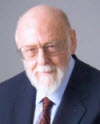 This 20Q article brings back a host of memories. In the winter of 1959 I spent a fruitful week in Montreal visiting colleague and good friend, Earl Harford. Earl had just accepted a faculty position at McGill University and a supervisory position as chief audiologist at the Royal Victoria Hospital. During that week Earl and I visited the nearby Montreal Neurological Institute (MNI) where we had the good fortune to meet Herbert Jasper, originator of the 10-20 electrode system of the International Federation, and to observe the great neurosurgeon, Wilder Penfield, operate on a patient with epilepsy. But even more interesting for me was a visit to the laboratory of Brenda Milner at MNI. Here I met Brenda, and perhaps Doreen as well, although I do not remember doing so. I was shown the now famous "modest" stereo tape recorder on which they had recorded, somewhat laboriously, a set of dichotic digits in the manner of Donald Broadbent. This was two years before the publication of the now famous 1961 paper by Doreen in the Canadian Journal of Psychology.
This 20Q article brings back a host of memories. In the winter of 1959 I spent a fruitful week in Montreal visiting colleague and good friend, Earl Harford. Earl had just accepted a faculty position at McGill University and a supervisory position as chief audiologist at the Royal Victoria Hospital. During that week Earl and I visited the nearby Montreal Neurological Institute (MNI) where we had the good fortune to meet Herbert Jasper, originator of the 10-20 electrode system of the International Federation, and to observe the great neurosurgeon, Wilder Penfield, operate on a patient with epilepsy. But even more interesting for me was a visit to the laboratory of Brenda Milner at MNI. Here I met Brenda, and perhaps Doreen as well, although I do not remember doing so. I was shown the now famous "modest" stereo tape recorder on which they had recorded, somewhat laboriously, a set of dichotic digits in the manner of Donald Broadbent. This was two years before the publication of the now famous 1961 paper by Doreen in the Canadian Journal of Psychology.
In this era of super technology, in which instrumentation grows ever more complex, it is refreshing to remind ourselves that many important breakthroughs were achieved by well-trained and clever people using what must be described by today's standards as exceedingly primitive equipment. The discovery of the right-ear advantage in dichotic listening was one such breakthrough. A better tape recorder would have been fine, but the really crucial ingredient was that the MNI investigators, Milner & Kimura, were trained to ask the right questions and gather and appreciate the right evidence. Their basic knowledge of the neuroanatomy and neurophysiology of the central auditory pathways, coupled with their understanding of how language processing is asymmetrically represented in the brain, permitted them to make sense of what might have seemed, to less well-trained individuals, an unexplained anomaly in the data.
It is noteworthy that after 50 years of research on the REA, Doreen's original structural hypothesis has retained much of its explanatory strength. In the intervening years we have learned a good deal about attentional and other cognitive influences on dichotic listening, but Doreen's structural explanation, based on crossed pathways, the suppression of ipsilateral by contralateral pathways, and the representation of linguistic processing in the left hemisphere in most individuals, remains an essential ingredient for understanding this basic asymmetry in sensory and perceptual processing.
I congratulate Dr. Kimura anew on her unique accomplishment, and I congratulate Gus Mueller on putting together this remarkable article.
From Jack Katz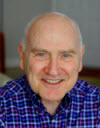 What a fascinating 20Q article by Doreen Kimura. I am amazed by the breadth of her work and her general discussion of brain asymmetries. Much of these contributions are often taken for granted as people do not know where these powerful concepts came from.
What a fascinating 20Q article by Doreen Kimura. I am amazed by the breadth of her work and her general discussion of brain asymmetries. Much of these contributions are often taken for granted as people do not know where these powerful concepts came from.
I was working on the SSW test at the same time that Dr. Kimura was developing her adaption of Broadbent's test. I was a little more fortunate in recording the first SSW test as I found a reel-to-reel tape recorder (Korting) that permitted us to record on each channel separately. We recorded the second channel based on the first word in the first channel so that it would coincide with the second word. But it was trial and error. To make sure that the competing words were 'perceptually centered' we then listened to both channels at the same time and rerecorded the second channel as needed.
To this day I continue to explain dichotic listening effects based on the anatomical diagram that Kimura provided in 1961. This and the explanation for the right-ear-advantage have played an important role in my understanding of the dichotic process. In fact, just recently I became aware of another asymmetrical auditory phenomenon that I had never noticed before. So even after 50 years, Dr. Kimura's work continues to impact my thinking.
From Frank Musiek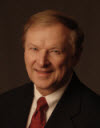 Doreen Kimura is one of the most famous and respected neuropsychologists of the past half century. Unfortunately, many audiologists do not know of her many outstanding contributions, partly because most of her research has been published in psychology and neuroscience journals. Without question, her work has had a profound influence on our knowledge of central auditory function and dysfunction.
Doreen Kimura is one of the most famous and respected neuropsychologists of the past half century. Unfortunately, many audiologists do not know of her many outstanding contributions, partly because most of her research has been published in psychology and neuroscience journals. Without question, her work has had a profound influence on our knowledge of central auditory function and dysfunction.
As Gus mentioned in his introduction to this 20Q article, she published two classic papers in 1961, both on dichotic listening. Dr. Kimura was perhaps the first to show the marked effect of temporal lobe lesions on dichotic listening. As she discussed in this 20Q article, she employed a carefully designed approach and demonstrated the contralateral ear effect for patients with temporal lobe compromise using her dichotic digit listening task. Moreover, in 1961 she formulated a now well accepted theory on the brain mechanisms underlying dichotic listening. Key to this hypothesis was the suppression of ipsilateral pathways in dichotic listening. This was a concept that our lab was able to quantify by the investigation of dichotic interaural intensity differences in split brain patients many years later. Dr. Kimura also made historic contributions to the hemispheric specialization of music and more recently on gender differences in cognition.
Early in my career I read about Kimura's work and it motivated me to study her dichotic listening tasks. She used three digits presented to each ear. I believed this was too much of a memory strain and I felt compelled to develop a more clinically friendly dichotic procedure. Henceforth, our dichotic digit test using only two digits to each ear evolved, which we introduced in the early 1980s.
I first met Dr. Kimura at a symposium in Canada around the time we were developing our test. I recall that people talked about her work with great admiration and respect then as they do today. I personally believe Dr. Kimura has not only profoundly impacted our understanding of dichotic listening but also the understanding of neural mechanisms in healthy and brains with various disorders. She truly is a giant in auditory as well as other sensory brain processes.
back to article
References
Broadbent, D.E. (1956). Successive responses to simultaneous stimuli. Quarterly Journal of Experimental Psychology, 8, 145-162.
Broadbent, D.E. & Gregory, M. (1964) Accuracy of recognition for speech presented to the right and left ears. Quarterly Journal of Experimental Psychology, 16, 359-360.
Curry, F.K.W. (1967). A comparison of left-handed and right-handed subjects on verbal and nonverbal dichotic listening tasks. Cortex, 3, 343-352.
Durnford ,M. & Kimura, D. (1971). Right-hemisphere specialization for depth perception reflected in visual field differences. Nature, 231, 394-395.
Gibson, C. & Bryden, M.P. (1983). Dichaptic recognition of shapes and letters in children. Canadian Journal of Psychology, 37, 132-143.
Kimura, D. (1961a). Some effects of temporal-lobe damage on auditory perception. Canadian Journal of Psychology, 15, 156-165.
Kimura, D. (1961b). Cerebral dominance and the perception of verbal stimuli. Canadian Journal of Psychology, 15, 166-170.
Kimura, D. (1963a). Speech lateralization in young children as determined by an auditory test. Journal of Comparative and Physiological Psychology, 56, 899-902.
Kimura, D. (1963b). A note on cerebral dominance in hearing. Acta Otolaryngolica, 56, 617-618.
Kimura, D. (1964). Left-right differences in the perception of melodies. Quarterly Journal of Experimental Psychology, 16, 355-358.
Kimura, D. (1966). Dual functional asymmetry of the brain in visual perception. Neuropsychologia, 4, 275-285.
Kimura, D. (1969) Spatial localization in left and right visual fields. Canadian Journal of Psychology, 23, 445-458.
Kimura, D. (1973a), Manual activity during speaking—I. Right-handers. Neuropsychologia, 11, 45-50.
Kimura, D. (1973b). Manual activity during speaking—II. Left-handers. Neuropsychologia, 11, 51-55.
Kimura, D. (1983). Speech representation in an unbiased sample of left-handers. Human Neurobiology, 2, 147-154.
Kimura, D. (1993). Neuromotor mechanisms in human communication. New York: Oxford.
Kimura, D. & Durnford, M. (1974). Normal studies on the function of the right hemisphere in vision. In S.J. Diamond & J.G. Beaumont (Eds.), Hemisphere function in the human brain (pp. 25-47). London: Paul Elek (Scientific Books) Limited,
King, F.L. & Kimura, D. (1972). Left-ear superiority in dichotic perception of vocal nonverbal sounds. Canadian Journal of Psychology, 26, 111-116.
Knox, C. & Kimura, D. (1970). Cerebral processing of nonverbal sounds in boys and girls. Neuropsychologia, 8, 227-237.
Kolb, B., Milner, B. & Taylor, L. (1983). Perception of faces by patients with cortical excisions. Canadian Journal of Psychology, 37, 8-18.
Ley, R.G. & Bryden, M.P. (1982). A dissociation of left and right hemispheric effects for recognizing emotional tone and verbal content. Brain and Cognition, 1, 3-9.
Milner, B. (1962) Laterality effects in audition. In V. Mountcastle (Ed.), Interhemispheric relations and cerebral dominance (pp. 177 - 195). Baltimore: Johns Hopkins Press.
Milner, B. & Taylor, L. (1972). Right-hemisphere superiority in tactile pattern-recognition after cerebral commissurotomy: evidence for nonverbal memory. Neuropsychologia, 10, 1-15.
Minami, K., Hay, V., Bryden, M.P., & Free, T. (1994). Laterality effects for tactile patterns. International Journal of Neuroscience, 74, 55-69.
Rosenzweig, M.R. (1951). Representations of the two ears at the auditory cortex. American Journal of Physiology, 167, 147-158.
Seashore, C.E., Lewis, D., & Saetveit J.G. (1960) Seashore measures of musical talents. New York: Psychological Corporation (Revised).
Shaywitz, B.A., Shaywitz, B.E., Pugh, K.R., Constable, R.T., Skudlarski, P., Fulbright, R.K., et al. (1995) Sex differences in the functional organization of the brain for language. Nature, 373, 607-609.
Tunturi, A.R. (1946). A study on the pathway from the medial geniculate body to the acoustic cortex in the dog. American Journal of Physiology, 147, 311-319.
Yovel, G., Levy, J., Grabowecky, M. & Paller, K.A. (2003). Neural correlates of the left-visual-field superiority in face perception appear at multiple stages of face processing. Journal of Cognitive Neuroscience, 15, 462-474.

